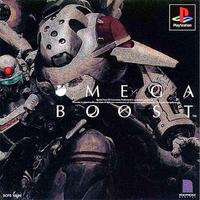 In 1999 a developer renowned for its pedigree in creating driving simulators ventured into pastures where high speed mecha roam. The developer was Polyphony Digital, the game: Omega Boost for the original PlayStation.
In 1999 a developer renowned for its pedigree in creating driving simulators ventured into pastures where high speed mecha roam. The developer was Polyphony Digital, the game: Omega Boost for the original PlayStation.
It was possibly the most accomplished implementation of mecha themed space combat yet achieved.
The player had control over the titular mecha, the Omega Boost, and were able to acquire targets in spherical 3D at incredible speed. Considering the aesthetic influences from anime such as Macross, it was unsurprising that Shoji Kawamori helmed the mecha design with his regular finesse.
Many assumed that the game was an offshoot from Team Andromeda’s seminal Panzer Dragoon series, as the beautifully insane homing lasers were in similar effect. It became an almost apocryphal tale, that was supposedly wholly without credence.
Well, Yuji Yasuhara would probably disagree…
From dragons to mecha…
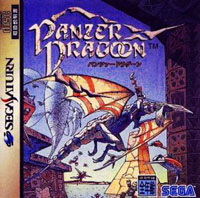 The first Panzer Dragoon was an iconic on-rails shoot-em-up, which had the player mount a dragon that could fire homing beams from its mouth. The aim of the game was to sweep your cursor over as much of the screen as possible, snagging as many enemies as possible. It sounds simple enough but in actuality, it was quite a challenge. Games like Rez owe a lot to the original Panzer Dragoon, as they distill this focused approach even further.
The first Panzer Dragoon was an iconic on-rails shoot-em-up, which had the player mount a dragon that could fire homing beams from its mouth. The aim of the game was to sweep your cursor over as much of the screen as possible, snagging as many enemies as possible. It sounds simple enough but in actuality, it was quite a challenge. Games like Rez owe a lot to the original Panzer Dragoon, as they distill this focused approach even further.
The second game in the series is more interesting though. Sure, the first Panzer Dragoon got the ball rolling but Zwei, its sequel, is actually more influential and also a far more accomplished game.
It’s difficult to encapsulate the sheer focused pacing seen in Zwei, to this day it probably remains the most important of all the Panzer Dragoon games (even more so than Azel, or Saga as it’s known in the West, and definitely leagues ahead of Orta). Zwei also had a rather notable programmer on its team; Yuji Yasuhara.
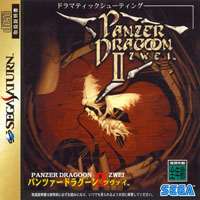 Admittedly, he wasn’t an official member of the posse known as Team Andromeda but he did help code the game. It wasn’t long after Zwei was released that Yasuhara jumped ship to more fiscally stable waters in the shape of Polyphony Digital.
Admittedly, he wasn’t an official member of the posse known as Team Andromeda but he did help code the game. It wasn’t long after Zwei was released that Yasuhara jumped ship to more fiscally stable waters in the shape of Polyphony Digital.
It wasn’t long after that when Omega Boost would have started. Obviously, Yasuhara made enough of an impression to get the green light on a Panzer Dragoon-esque shoot-em-up with him at the design and coding helm.
That would have been quite a feat to land something like that back in 1999, doubly so considering that it was at a Japanese developer which eschews the nexus of ego that you normally see in the West.
In any case, the effects of Panzer Dragoon Zwei had a tangible creative outcome. Chanelled through one man to make something that, to this day, isn’t truly appreciated for its unfettered brilliance.
The Mechanical Circus
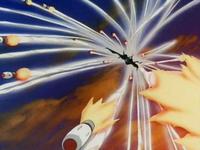 Why all the fuss then? What makes Omega Boost so different from the slew of mecha mediocrity out there?
Why all the fuss then? What makes Omega Boost so different from the slew of mecha mediocrity out there?
Well, let me explain how mecha combat has been portrayed for the last 25 years. Specifically, since 1982 Macross beamed across Japanese televisions showing beautifully balletic aerial dogfights with planes that could transform into mecha. The series then evolved very quickly into space based battles were acquiring targets without the paltry limitations of gravity came into full effect. Couple all this with swarms of missiles chasing their targets with an iconic demented glee and you have a very potent aesthetic mix.
So potent in fact, that no-one had been able to accurately reproduce that in game form. When I say no-one, I really mean it as well. Bandai tried to many Macross games over the years and they all tanked horribly, not only fiscally but also functionally. The first real attempt at 3D space combat was with Macross Digital Mission VF-X, though the less we talk about that the better.
Even Virtual On turned a blind eye to the likes of Macross and had its combat occur in a suitably planar fashion. No-one wanted to the poison chalice that was the holy grail of mecha gaming; a full blown spaced based mecha battle. No-one, except Yuji Yasuhara it seems.
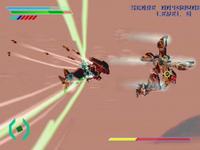 Omega Boost approached the premise in a simple but uncompromising way; have the player acquire targets spherically at their own discretion and give them a simple lock-on that can be re-acquired instantly. With the latter, the game offered almost no HUD based elements to indicate what had been targeted but instead focused the camera on that point, or the nearest target that was within that area when the lock-on button was pressed. Releasing the button would then allow the player to fly freely and manually track targets if they so wanted.
Omega Boost approached the premise in a simple but uncompromising way; have the player acquire targets spherically at their own discretion and give them a simple lock-on that can be re-acquired instantly. With the latter, the game offered almost no HUD based elements to indicate what had been targeted but instead focused the camera on that point, or the nearest target that was within that area when the lock-on button was pressed. Releasing the button would then allow the player to fly freely and manually track targets if they so wanted.
One of the few HUD elements was a very conservative yellow targeting cursor that showed which way Omega Boost was effectively pointing, meaning that to fire its vulcan cannon you had to place the reticule on the target. If the player held down the firing button though, then the functionality changed and as you sweeped the reticule over an enemy it produced multiple lock-ons. Releasing the button would result in the familiar swarm of homing lasers.
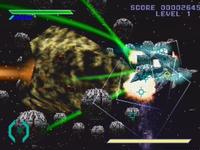 Whilst these lasers were the crux of the Panzer Dragoon lineage, their true origin was squarely a result of Ichiro Itano’s work on Macross (something that has already been covered at great length in this column). So having Kawamori on the mecha design helm only cemented Omega Boost’s functional roots even further.
Whilst these lasers were the crux of the Panzer Dragoon lineage, their true origin was squarely a result of Ichiro Itano’s work on Macross (something that has already been covered at great length in this column). So having Kawamori on the mecha design helm only cemented Omega Boost’s functional roots even further.
However, Omega Boost had one more anime reference up its sleeve. It wouldn’t be a high speed mecha game without at least one nod to Layzner. Something this game had quite blatantly in fact, as after the first few levels the player unlocked an attack called the Viper Boost. This had the Omega Boost glow blue and enter into a spherical energy shield as it homed in on targets and blithely rammed them. The sixth level, where the player faces a fleet of battleships in orbit around a planet, is an ideal example of this attack. For those familiar with Layzner, and it’s similarly potent V-MAX attack, then the Viper Boost’s resemblance is uncanny. Even more so when you realise that the Beta Boost, your mechanical nemesis, has a similar attack but instead glowed yellow. Again, mirroring the V-MAX attack of the Zakarl from Layzner.
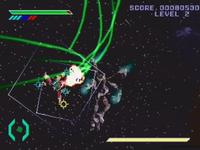 To make matters even more implicit, the mecha would always been boosting in whatever direction it was facing. This could be turned off admittedly but it gave a momentum to the gameplay and help with the player’s evasion of enemy weapons fire.
To make matters even more implicit, the mecha would always been boosting in whatever direction it was facing. This could be turned off admittedly but it gave a momentum to the gameplay and help with the player’s evasion of enemy weapons fire.
What threw some people, and by some people I mean provincial American journalists, was that the enemies came in waves of attack. This simple and obvious design choice had the game lumped in as an “old school shoot-em-up” like R-Type and Gradius. Despite the mind boggling idiocy in regards to such a major simplification and almost forced ignorance to the remainder of the game, the game did utilise waves of attack but the implementation up to that point was wholly different from the shooters of old. Omega Boost removed the functional allegory of Gradius and re-created, almost perfectly, a fully formed spaced based battle that allowed the player to go almost wherever they wanted.
However, this is where Panzer Dragoon Zwei’s heritage comes into play. Whilst the game did allow tracking of targets all around the player you were funneled through environments. Not in an overt on-rails manner but enough to notice a sense of progression that felt similar. Though the stages where you zoomed through a tunnel were obviously more straightforward in that regard.
Expensive Production Values
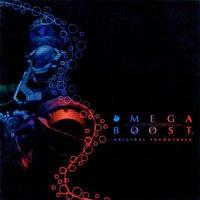 Despite the functional finesse of Omega Boost, the real eye opener back in 1999 was it’s FMV and aural production values. As the FMV’s throughout the game feature live actors blended with CG, all directed by Kawamori. Even the pilot of the Omega Boost, played with a fervent apathy by the brilliantly named Greg Funk, had his space suit designed by Kawamori.
Despite the functional finesse of Omega Boost, the real eye opener back in 1999 was it’s FMV and aural production values. As the FMV’s throughout the game feature live actors blended with CG, all directed by Kawamori. Even the pilot of the Omega Boost, played with a fervent apathy by the brilliantly named Greg Funk, had his space suit designed by Kawamori.
Even the music to accompany the opening eye candy was specifically catered for each region of release. With Japan having Feeder’s “Shade” from it’s Swim EP (no doubt due to Taka Hirose’s gaming passion), the UK having Cast’s “Dreamer” from their last album and the US receiving Loudmouth’s “Fly”. Naturally, the Japanese release used Shade more in time with visuals but that’s hardly a surprise considering the game was released there first.
The original game soundtrack is another matter entirely though, as it’s incredibly rare these days. Though this is more to do with Omega Boost’s rather lackluster sales in Japan and the soundtrack consequently had a very limited run.
The cover art as well, which many mistook to be a Kawamori work, was done none other by Yoshiyuki Takani. A veteran painter who worked throughout the anime industry and making a name for himself by doing the cover art for mecha model kit boxes, which is a wonderful parallel considering the game’s subject matter.
A forgotten renaissance…
Despite Omega Boost hitting all the right beats from start to finish, it was ultimately several steps too far for the gaming populace to keep up with. It sold initially quite well in Japan but reports of motion sickness were quite common and the game was tarnished as a consequence. Whereas abroad it was more of a sleeper hit and had a few toys released along with it (don’t bother trying to buy them though, as they were pretty awful).
It also confused people that a renowned car game developer managed to put out a very polished space based shoot-em-up, as many of the press didn’t really approve of the creative tangent. Polyphony Digital responded almost silently and now the game is no longer listed on their official site.
It’s an incalculable shame that Yasuhara’s vision wasn’t appreciated for its sheer all encompassing brilliance. It pushed the genre of mecha gaming into areas that it should have always resided within and made that leap to almost giving the player the chance to sit inside the cockpit of a mecha blasting through a frenetic battle in outer space. Looking back on the decade since is almost heartbreaking, as mecha games have taken several steps back functionally.
Of all the mecha games that deserved numerous sequels and its team to be universally praised, it would be Omega Boost. Unfortunately, Yasuhara and his talented ilk now have the unenviable task of buffing the pedestrian irrelevance that is a Toyota Yaris to a cold, dead and uninspired shine.
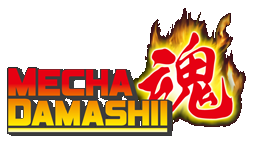
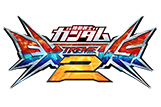
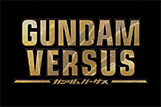








One of THE best games of all time. Gameplay, design, aesthetic, sound: Awesome. I still play it. Huge fan. Nothing has come close.
Where’s the next-next-gen sequel?
If you are at all into mechs, don’t hesitate to buy this game and play on your PS1, PS2 and maybe PS3.
Hugely satisfying even now.